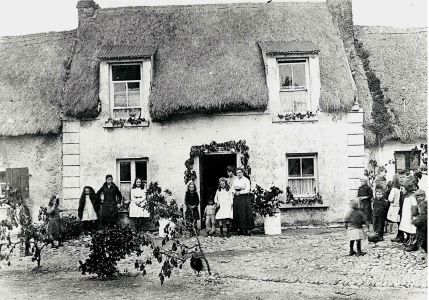Old Galway
NOLLAIG NA mBAN

by Tom Kenny
Owing to liturgical differences, the Churches of the Eastern Roman Empire celebrated Christmas Day on the 6th of January while those in the Western Roman Empire Churches did so on December 25th. In October, 1582, Pope Gregory XIII introduced the Gregorian calendar as a correction to the Julian calendar, which meant Christmas Day was now celebrated on December 25th, and “Old Christmas” on January 6th, the Feast of the Epiphany. This feast day celebrates the manifestation of the Son of God on earth, and also marks the end of the 12 days of Christmas.
THE BELLS OF ST. NICHOLAS

by Tom Kenny
There are ten bells in St. Nicholas’ Collegiate Church, cast at seven different dates from 1590 to 1898. They were hung for ringing by Mr. H.S. Persse when he gave two new bells in 1891. After some time it was seen that the vibration was putting a great stress on the old tower and ‘chiming’ was substituted for ‘ringing’. Unfortunately the method of chiming was not satisfactory and one after another the bells cracked, until, in 1930, only three of the bells could be used. The Clock Bell being only used for the hour’s strike and the “Clifton” bell being out of tune.
A CLADDAGH CHRISTMAS LONG AGO

by Tom Kenny
These were the memories of Christmas in the Claddagh long ago as recalled by Martin Geary of Father Griffin Road and published in this paper in 1979.
“All the people of the street would start cleaning up, whitewashing, painting, a month before it. The smell of whitewash was grand. Well a few days before it, they would start putting up the holly. A woman used to make red roses from paper. She would put some wire at the bottom and put them on the holly, then the chains with lanterns, also paper mottos they were called. On these would be wrote ‘What is home without a mother’, ‘Merry Christmas’ and so on. They would be fancy decorations.
JOYFUL CHAOS, THE CHRISTMAS MARKET

by Tom Kenny
For many people, the Christmas market takes place in Eyre Square and involves a big wheel, hurdy-gurdies and German beer tents. For others, it is part of a Galway tradition that goes back some 800 years under the shadow of the old grey St. Nicholas’ Collegiate Church. This was the fruit and vegetable market which expanded greatly at this time of the year with the big influx of turkeys and geese for sale.
Some aspects of Galway postal history

by Tom Kenny
The idea for regular stages for carrying letters is as old as history itself. The regular use of the words “post” and “litir” in 15th century Irish manuscripts suggests that by that time a postal system was already in existence here.
One hundred and ninety five years of the Patrician Brothers in Galway

by Tom Kenny
In 1790, the Rev Augustine Kirwan, Catholic warden of Galway, established the Galway Charity School near the Shambles Barracks for the education of poor boys. For a variety of reasons, the school failed and eventually, the Brothers of St Patrick, also known as the Patrician Brothers, an order founded in 1808, were invited to take charge.
THE RAILWAY HOTEL

by Tom Kenny
This ancient site on the southern end of what we now know as Eyre Square was occupied by a Knights Templars convent in the 13th century. By the 17th century Robert Martin had a large house on the site, but this was taken from him by the Cromwellians and given to Edward Eyre. The Eyre family held on to the property and on May 12th, 1712, Edward Eyre, son of the above, presented the land in front of his house to the Corporation as a place of recreation for the people of Galway. In 1827, a man named Atkinson built houses at this end of the Square and by 1845, the site was occupied by a block of tenements owned by Fr. Peter Daly.
THE BROWNE DOORWAY

by Tom Kenny
According to a Browne family tradition, the first Browne to settle in Ireland was Phillipus de Browne who, in 1172, was appointed Governor of Wexford. He had three sons, one of whom, Walter, settled in County Galway, where his posterity still remains. By around the year 1300, the Brownes seemed to have settled in the Athenry area. They were one of the fourteen families from the Irish lower classes who rose to become one of Galway’s prime merchant families who famously were known as The Tribes of Galway.
